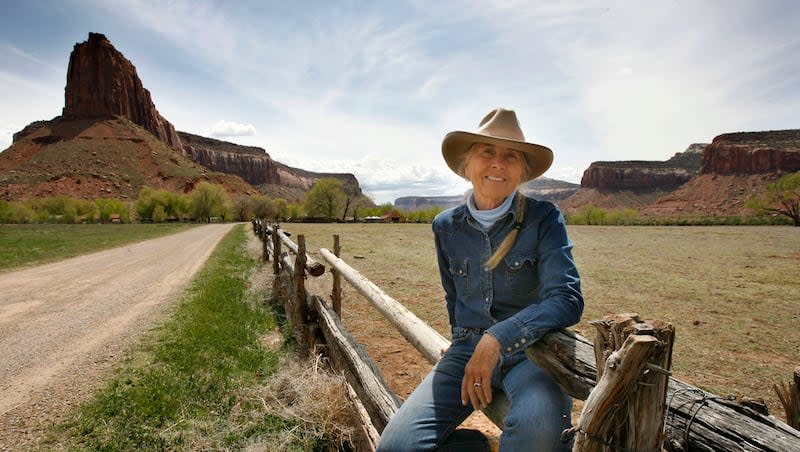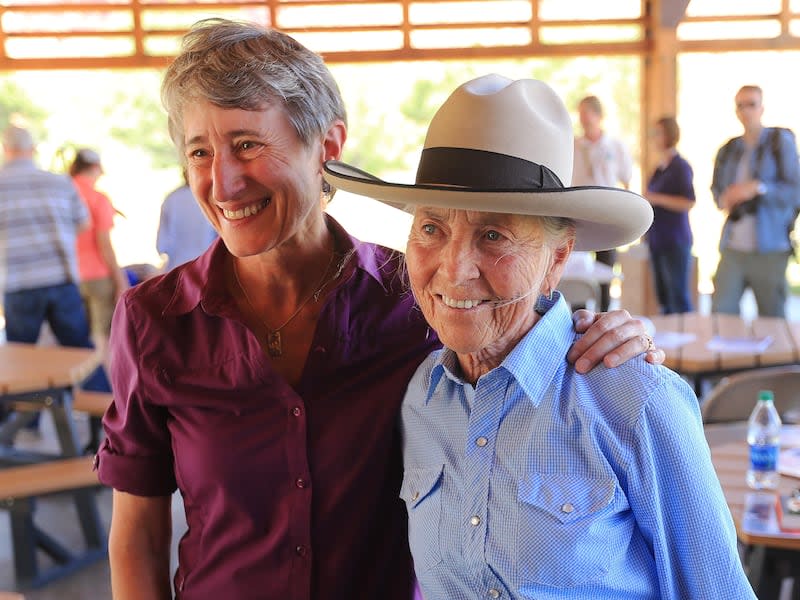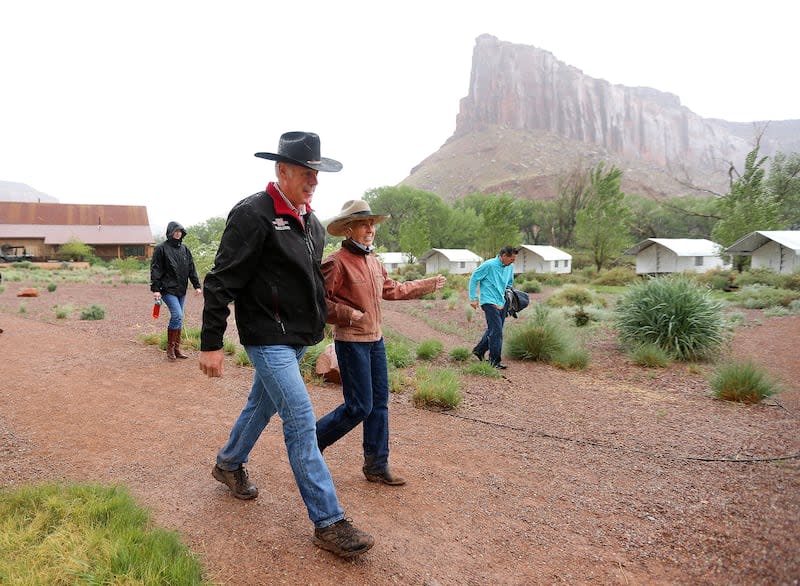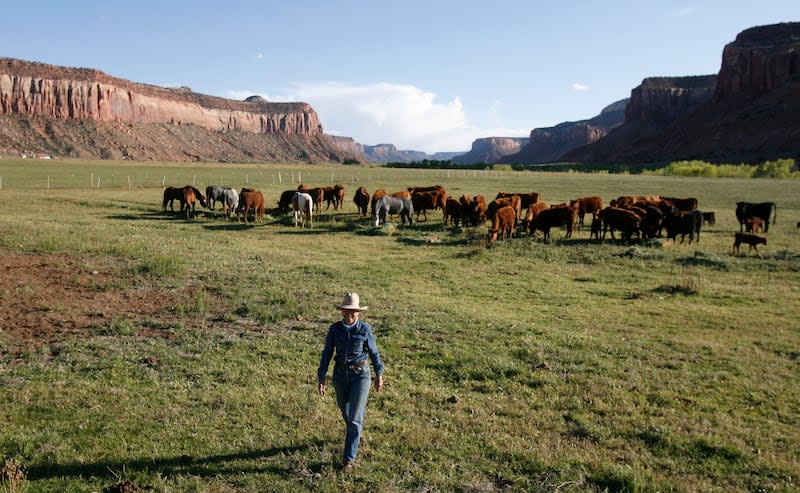From cowgirl to conservation and encountering the bear

- Oops!Something went wrong.Please try again later.
When former Interior Secretary Sally Jewell visited southern Utah to take a look at the proposed Bears Ears National Monument in 2016, she was struck by its rugged and sacred beauty.
As part of the event-packed itinerary, she was hosted by rancher Heidi Redd and her family at the Dugout Ranch, nestled among canyon walls and cliffs, sprouting lush landscapes, a pair of creeks and cattle contently grazing. The ranch includes more than 5,000 acres of pasture land, water rights and permits to graze the cattle on more than 350,000 acres of adjacent federal land.
“Heidi’s deep connection to these landscapes came alive through her stories. Her words made me laugh, weep and appreciate that very few people possess the skill, courage and tenacity needed to be a cowgirl or cowboy,” Jewell wrote in a foreword in a new book called “A Cowgirl’s Conservation Journey: Stories from the Dugout Ranch.”
The book is available at local Utah bookstores while supplies last and on Amazon with proceeds going to The Nature Conservancy in Utah. More can be discovered at this website.
“You know, I think one of the things as we get older, we begin to understand how all the pieces fit together. And Heidi is just a great illustration of understanding how the systems all work,” Jewell said in a telephone interview with the Deseret News. “How the pieces fit together, how important it is to listen, and how important it is to work together collectively on these landscapes that are feeling the impact of climate change and change overall — so I am huge fan of the ranch.”
A conversation about conservation
Redd no long actively runs cattle, but still makes the ranch her home. It is in her soul, part of her fabric.
She also told the Deseret News she was keenly aware of the mounting pressures on the land, the coming growth to the region, the threat of condos, “glamping” resorts or millionaires’ homes that would compromise everything she and her family worked so hard to maintain, improve and steward.
As one of most significant conservation and ranching properties in the West, the Dugout Ranch is adjacent to the Needles District of Canyonlands National Park and is the largest private inholding in Bears Ears National Monument. In 1997, The Nature Conservancy purchased the Dugout, joining with Redd and her family to preserve the ranch from that coming development, as well as to foster the growing alliance between ranchers and conservationists.

It wasn’t easy. It took months and months of negotiations and media blitz stoking charitable donations to make it happen.
“In every meeting, in every forum, Heidi was our ace in the hole. Eloquent, spirited, committed, a lover of the land — always perfectly dressed in her signature cowgirl hat and western garb — Heidi turned heads. She was genuine and irresistble. She was the real thing in a West becoming increasingly gentrified,” wrote Dave Livermore, former Utah state director of The Nature Conservancy, in the foreword of the book. “We could not have raised the money we did without her.”
Eventually, the worldwide conservancy organization established the Canyonlands Research Center at the ranch, which hosts scientists and stakeholders from around the world to study and compare notes on drylands restoration and range management — extending the tendrils of the ranch’s influences far beyond San Juan County.
Situated on the Colorado Plateau, the ranch is an ideal place to study what works in the arena of watershed restoration. Both Indian Creek and Cottonwood Creek are vital water rights for The Nature Conservancy and tie into the importance of the Colorado River Basin water flowing in this arid region.
From branding, herding, eating dust and meeting celebrities
Redd blends her no-nonsense approach and candor with style and grace. She grew up a daredevil, and over the decades, the ranch has tested but not conquered her will.
Born in Ogden in 1942, Redd’s built-in genetics took her down a path of adventure, rock climbing, sky diving, scuba diving, becoming the town’s head lifeguard at the age of 12 and talking her parents into letting her keep a horse named Brownie she’d bought from the local fair with $5 she had saved up with bottles and babysitting money.
Although she earned a degree, she found her true passion in the land — not the classroom.
Her story is chronicled in the book via a collection of stunning photos and artful prose that captures her struggles, her triumphs, her heartbreaks and her grit.
In 2022, she was inducted into the National Cowgirl Museum and Hall of Fame. A picture from the book shows her posing with country singer legends and husband and wife team Faith Hill and Tim McGraw.

The Dugout Ranch has been a staple for commercials and movie filming. It was just a few years ago that Kevin Costner — who has a penchant for Utah landscapes — made an appointment to visit the ranch.
Redd said they talked for a while and later decided to scramble up a steep hill. She said as a gesture of chivalry, Costner extended his hand to help her.
“He’s probably a gentleman that thought this 80-year-old woman couldn’t make it up that hill. And he was just going to be nice about it,” she said. “I thought, ‘Is he holding my hand because he thinks I can’t get up that hill?’ It was a kind gesture, but I have this competitive instinct (in) me that says, ‘OK, I am going to pull you up that hill.’”
Uncooperative cattle, the encounter with ‘Mr. Bear’ and weather
“You’ve likely seen herding look romantic and epic in the movies,” Redd writes in the book. “Well let me tell you the reality was often exasperating and downright ugly. The cattle frequently hid in the brush, bolted from us or dove down to the bottom of steep arroyos.”
She detailed a harrowing night spent on a mountain, with her and her horse, “Mr. G,” painfully trudging through the deep snow, sides heaving with the wind and sleet slapping their faces. They made it to the top, and she reached for her emergency survival kit tucked away in a saddlebag.
A makeshift fire helped them make it through the night, but before they started to doze and rest and weighing the odds of potentially freezing to death, Redd decided to untie Mr. G so that if anything happened to her, he would be free to find his way home. They survived the night, and a little more than five hours later, reached the hitching post at headquarters. She gave the horse extra hay and a big can of oats and before turning him out to the pasture, she stood on her tiptoes, wrapped her arms around his neck to plant a kiss on his mane.
One September, the ranch had an encounter with Mr. Bear, likely an older male who had lost his territory to a young competitor. He had made it plain he had no intention of leaving, posing a threat to the animals at the ranch, and the people who worked there.
One ranch hand threw a lasso around the bear’s neck as it perched on the largest branch of a tree, about six feet off the ground. The bear was soon out of the tree, and this time, another rancher lassoed his back legs. The animal was stretched out much like a calf on branding day, Redd observed.
Unceremoniously and not without grave danger, the bear was shoved into the back of a horse trailer, with his “howl of fury” shaking the truck. He ultimately was transferred to the custody of the local Fish and Game officer and taken to the other side of the mountain, far away from the ranch, and released back into the wild.
These and other riveting stories are intricately woven throughout the book, which is full of near misses, laughter and some tears.
Redd’s son, Matt, runs the Canyonlands Research Center, the Dugout Ranch and cattle operation. Heidi Redd’s retirement did not mean she gave up her saddle or misses out on any of the action.
“We humans attach a lot of affection to our animals, whether they’re dogs, cats, horses or cattle. And I would say that the animal that I probably attach most to is a horse because first of all, I don’t know why in the heck they let us ride them,” she told the Deseret News. “Yeah, they can get rid of us immediately.”
She can rest, however, with the notion that Dugout will be preserved in perpetuity.
“In The Nature Conservancy, I felt I found a partner powerful enough to hold the dam from breaking,” she wrote.


